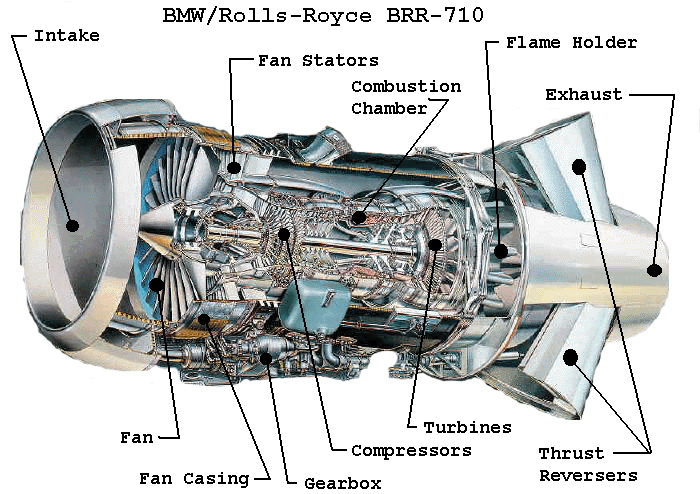
Principle
There are many everyday examples of jet propulsion. A blown-up toy balloon with its neck closed shows no tendency to move because the air inside is pressing equally in all directions. If the neck is opened suddenly, the balloon shoots away. The escaping air relieves pressure at the neck, and there is a reaction from the air opposite the neck. It is not the air rushing out of the neck and pushing against the outside air, however, that drives the balloon ahead. It is the air pushing against the inside front wall of the balloon that propels it forward. In fact, a jet would operate more efficiently in a vacuum because there would be no air to obstruct the escaping gases.
The recoil of a rifle also illustrates action and reaction. Expanding gases propel the bullet out of the barrel at high velocity. The rifle in response to the force of the gases "kicks back." Another example of jet action is the garden hose whose nozzle jumps back when the water is suddenly turned on full force.
A jet engine is much like any other four cycle, internal combustion engine. For example, the engine in a car, on a lawnmower, or even a
motorcycle have the same four cycles as a jet engine. They are:
The basic jet engine intakes air through the intake, compresses the air, mixes it with fuel, ignites the mixture, and the exhaust comes out to propel the engine (and the airplane) in a direction opposite of the exhaust flow.
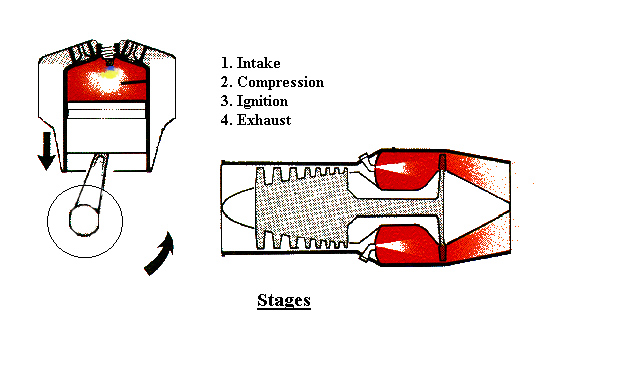
Types
There are several types of "jet" engines. You may also hear them called gas-turbine engines. The most prevalent types of gas-turbine engines (jets) appear below:
Turbojet engines.
The most widely used air-breathing engine is the turbojet. After the air is drawn into the engine through an inlet, its pressure is first increased by a component called a compressor. The air then enters the combustion chamber, where it is burned with fuel to increase its temperature. The hot, high-pressure gas then expands through a wheel-like device called a turbine, where it produces power. Think of the turbine working much like a windmill. The turbine is connected to the compressor by a shaft, and the power output of the turbine drives the compressor. At the turbine outlet the hot-gas pressure is still above that of the surroundings, and the final expansion takes place through an exhaust nozzle where the speed of the exhaust gas is increased. It is the final high-velocity jet that produces the thrust to push the plane through the air. Although in concept a jet engine is much simpler than a reciprocating engine that turns a propeller, the actual design for efficient operation is complex, and large jet engines are extremely costly. However, even the earliest jet engines were able to propel aircraft nearly 25% faster than the faster propeller driven aircraft of the time.
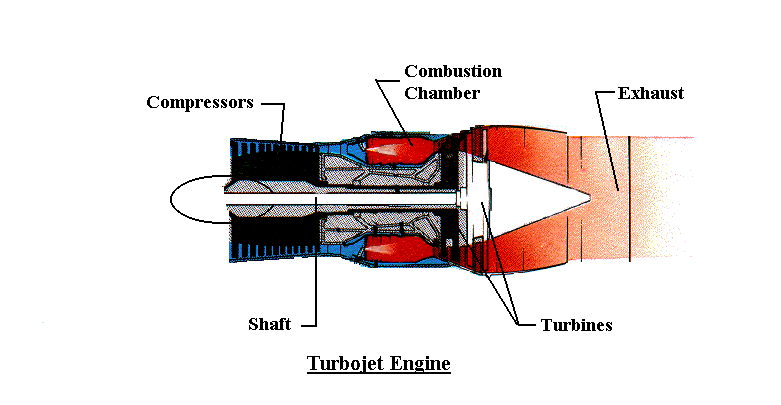
Turbofan engines.
Turbofan engines were the next step in the evolution of the jet engine. The turbofan gets its name from the large "fan" in front of the compressor stages of the engine. An extra set of turbines gets energy from the exhaust and powers the large fan at the front of the engine through a large shaft that runs down the center of the engine. Other than that minor difference, the turbofan engine is essentially the same as a turbojet.
The turbojet part of the turbofan engine is called the core of the engine. The core works just like a turbojet. The large fan in front pulls in an enormous volume of air. A large portion of this air actually goes around the outside of the core and does not undergo the combustion process. Instead, it travels past the core and meets the hot exhaust from the core. The cool "bypass" air helps lower the temperature of the core exhaust, is quieter, and more efficient at lower speeds than a pure turbojet. The ratio of air that bypasses the core in relation to how much air goes through the core is known as an engine s bypass ratio. For example, if 1000 cubic feet of air go into the intake of the engine, and 900 cubic feet of that bypass the core while 100 cubic feet go into the core....the engine is said to have a bypass ratio of 9 to 1.
Large commercial jet transports typically have large bypass ratios of 15 to 1. Some of the largest turbofans such as the Rolls-Royce Trent 80/90 and the General Electric GE90 power the Boeing 777 transport may have bypass ratios higher than 20 to 1!
In comparison, most fighter aircraft have relatively modest bypass ratios such as 1.75 to 1. In general, turbofans tend to be more efficient at high subsonic speeds, while turbojets tend to be more efficient at supersonic speeds. This is due to the high drag that a large, open-area intake on a turbofan tends to create. Turbojets are generally long and slender.


Ramjet engines.
The air into which an engine rushes at high flight speeds is partially compressed by the so-called ram effect. If the speed is high enough, this compression can be sufficient to operate an engine with neither a compressor nor a turbine. A ramjet has been called a flying stovepipe because it is open at both ends and has only fuel nozzles in the middle. A straight stovepipe, however, would not work; a ramjet must have a properly shaped inlet diffuser (also called a spike) that produces low-velocity, high-pressure air at the combustion section, and it must also have a properly shaped exhaust nozzle to increase the speed of flow.
Ramjets can operate at speeds above 200 miles (320 kilometers) per hour, but they become practical only at very high speeds, which must be greater than that of sound. Rockets or other similar devices are needed to produce the initial speed at which a ramjet can begin to operate.
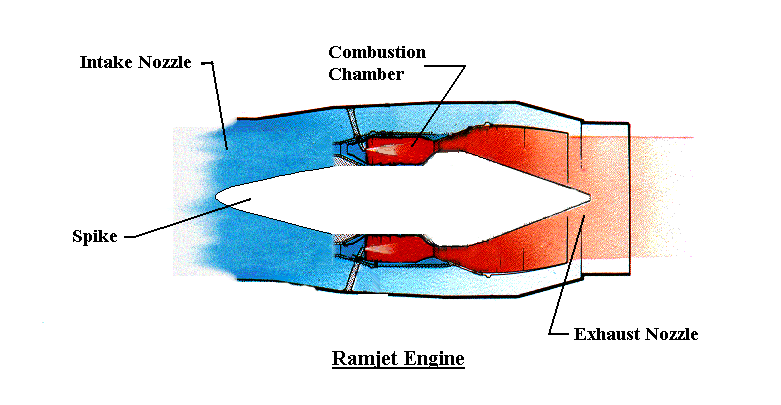
Scramjet engines.
The scramjet is a higher speed version of the ramjet, and, like the ramjet, it also has no moving parts. It gets its name from combining the words supersonic and ramjet. Thus, a scramjet is theoretically able to properly compress incoming air without the need to slow it to subsonic speeds first. Without this limitation, high supersonic (hypersonic) speeds are attainable. Ideally, a scramjet should be able to propel an aircraft as fast as Mach 10 (that s 10 times the speed of sound). Scramjets have been tested, but currently, there are no scramjet engines in production, as there are still many technical problems to overcome with such a high performance engine.
Pulse-jet engines.
A pulse-jet is similar to a ramjet except that a series of spring-loaded, shutter-type valves is located ahead of the combustion section. In a pulse-jet the combustion is intermittent or pulsing rather than continuous as in a ramjet. Air is admitted through the valves, and combustion begins. This increases the pressure and closes the valves, preventing backflow through the inlet. As the gases expand through the rear nozzle to produce thrust, the pressure in the combustion section drops to the point where the valves open again to admit fresh air. This cycle is then repeated.
The most widely known pulse-jet was the German V-1 missile, or "buzz bomb," which was used near the end of World War II and which fired at a frequency of about 40 cycles per second. Pulse-jets are inefficient, noisy, and subject to severe vibration. Their use is now limited to low-cost pilotless vehicles.
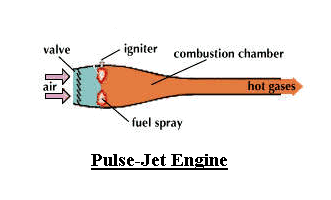
Turboprop engines.
In turboprop engines a conventional aircraft propeller is usually mounted in front of the jet engine and in one type of engine is driven by a second, or free, turbine. This is located behind the turbine that is driving the compressor. In other designs the power is obtained by additional stages on the main turbine.
Since turbine speeds are much higher than propeller speed, a reduction gear is required between the turbine and the propeller. About 90 percent of the energy in the hot gases is absorbed in the turbine, and only about 10 percent remains to increase the speed of the exhaust jet. Accordingly, only a very small portion of the overall thrust is produced by the jet; most of it comes from the propeller.
Turboprops are advantageous for small- and medium-sized planes and at air speeds from 300 to 400 miles (480 to 640 kilometers) per hour. They cannot compete with turbojets for very large planes or at higher speeds. However, they do combine the speed of a jet with the economy of a reciprocating piston engine.
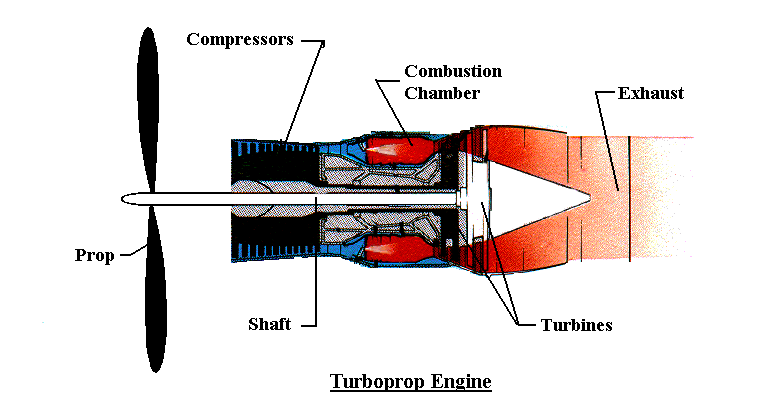
Turboshaft engines.
Components of a Gas-Turbine Engine.
Compressors
Today almost all airborne jet engines utilize axial-flow compressors. In these devices the air flows generally in one direction along the shaft that connects the compressor and the turbine; it moves through alternate rows of stationary and rotating sets of blades called stators and rotors respectively. The blades are arranged so that the entering air is slowed while passing through them and its pressure increased. Modern axial-flow compressors can increase the pressure 25-fold in about 16 "stages," each stage consisting of a set of rotor and stator blades.
Centifugal compressors, which were used in early aircraft jet engines, take air in at the center of an impeller, or vaned wheel, and compress it in a radial, or outward, direction. Lower efficiencies, a limited pressure rise, and large diameters that add to the drag of the engine assembly now limit the use of centrifugal compressors to small engines and to non-flight applications.
Combustion Chambers
Combustion chambers can be composed of individual cans, or cylinders, arranged around the turbine shaft. Another approach is the use of an annular chamber in which a liner, or tubular sleeve, surrounds the shaft.
Turbines
High-pressure ratio engines are built with two shafts rotating within each other. The outer one is a high-speed shaft, which can operate at about 11,000 revolutions per minute (RPM). It connects the high-pressure turbine and compressor stages. The inner shaft, operating at about 3,000 RPM, connects a low-pressure turbine and compressor portions of the engine.
Exhaust Nozzles
Performance Issues
A turbojet engine cannot be started directly from rest. An external starting motor starts the unit spinning. The fuel is then ignited by a heated spark plug. Once the engine is running, combustion can be maintained without a spark plug.
The useful output of the turbojet is its thrust, which is proportional to the mass flow rate of air through the engine and the change in velocity between the exit and the inlet. (Mass flow rate is the mass of a fluid in motion that crosses a given area per unit of time.) This makes it desirable to achieve a high velocity at the nozzle exit.
Two performance characteristics are commonly used to describe turbojets: the specific thrust and the specific fuel consumption. The specific thrust produced (units of thrust per unit of engine gas flow per second) increases with the turbine inlet temperature. For this reason engineers continuously seek higher turbine inlet temperatures by means of improved materials and better blade cooling. The specific fuel consumption (unit of thrust produced per unit of fuel burned per second), which is lowered as the engine efficiency is increased, improves with increasing pressure ratio. This requires more and more compressor stages. In an actual jet engine there must be a trade-off between high pressures and high temperatures for best overall performance.
Another important performance factor of the turbojet engine is the in-flight propulsion efficiency. In this case, the best performance is obtained if the jet exit (from the nozzle) velocity is about twice the flight velocity of the aircraft. As the thrust is increased by raising the turbine inlet temperatures, the turbine exit velocity also increases and the jet exit velocity becomes too high. In such a case, propulsion performance can be increased by adding bypass air, as discussed later in this article.
Maximum thrust is usually required at takeoff, while maximum efficiency is desired at the aircraft's cruising speed, which is about 500 to 550 miles (800 to 880 kilometers) per hour for most commercial airliners. For takeoff from a high-altitude airport on a hot summer day, the lower air density results in a lower mass flow rate of air through the engine and thus decreases the available thrust. In such a case, the plane may have to fly partially empty.
Since the combustion products leaving the turbine still have a large amount of oxygen contained in them (from the mixing of additional compressed air in the combustion chamber), it is possible to put another combustion chamber at the turbine exit. This so-called afterburner is used in some military aircraft to provide emergency bursts of speed. The fuel consumption in an afterburner is very high, however, so this thrust augmentation, or increase, is not practical for cruising or for commercial aircraft.
Water injection consists of introducing water into the compressor. This increases the thrust by cooling the air and thereby increasing both its density and the mass that can be passed for a given air velocity. Water injection can be used for emergency takeoff thrust, but the weight of water that is required to be carried on a plane does not make it desirable for in-flight operation.
As indicated above, it is desirable to have the average jet exit velocity about twice the air speed of the plane. A direct expansion of all the gases through the turbine would result in a jet velocity that would be too high for effective in-flight performance. Most modern aircraft jets now employ a turbofan, in which much of the air is only slightly compressed by a propeller-like compressor device at the front of the engine and then is passed around the engine core for mixing with the turbine exhaust gases, therefore bypassing the main engine. Bypass engines provide increased thrust for takeoff and climb, and they reduce jet noise. Modern engines may bypass five or six times the flow that goes through the engine core, and even higher bypass ratios are anticipated in the future for engines operating at higher turbine inlet temperatures.
In most commercial aircraft engines, the initial compression for both core and bypass flow is achieved by a large fan consisting of one or two compressor-like stages. After the flow has been divided, the core flow is further compressed, and the bypass flow is directed around the engine.
Problems, Limitations, and Dangers
Turbine engines tend to be noisy, which creates a problem in the neighborhood of airports. There is both a high-frequency noise, or whine, emanating from the compressor and a lower-frequency noise from the exit jet as it mixes with the surrounding air and produces turbulence. Compressor noise can be reduced by placing sound-absorbing material into the inlet ducting. The jet mixing noise is reduced by increasing the bypass air and by special mixers in the exhaust pipe. These mixers are corrugated to increase the area over which the hot and cool gases are in contact as they begin to mix.
At the tail of the engine is the thrust brake, or thrust reverser. This is a clamshell-like device activated by the pilot after landing. It closes over the jet exit nozzle to deflect the flow outward and slightly forward so that the thrust exerted on the plane is now backward, helping to brake the craft. With thrust reversers on, a jet plane can be made to roll backward on the ground.
The most serious problem a jet plane can encounter is the breaking off of a turbine or compressor blade if it is struck by a foreign object or if it breaks loose because of an internal engine failure. All engines must be designed with a casing strong enough to contain failing blades and to prevent a broken blade from cutting through the engine and damaging vital parts or from penetrating into the passenger space.
The most serious problem facing the compressor is posed by birds. All engines must be able to "swallow" a heavy bird without catastrophic failure, since birds can be unpredictably sucked into jet engines at low altitudes or on the ground.
In the event of engine failure in flight, the engine must be shut down. All multi-engine planes can land safely on one engine so that there is little more than inconvenience to the passengers involved if the plane must turn back for safety reasons.